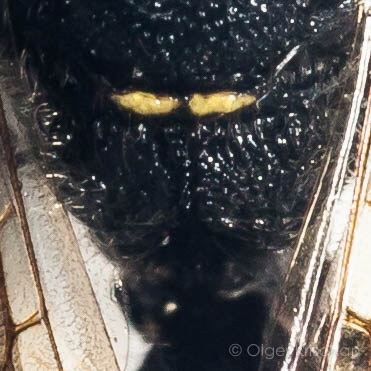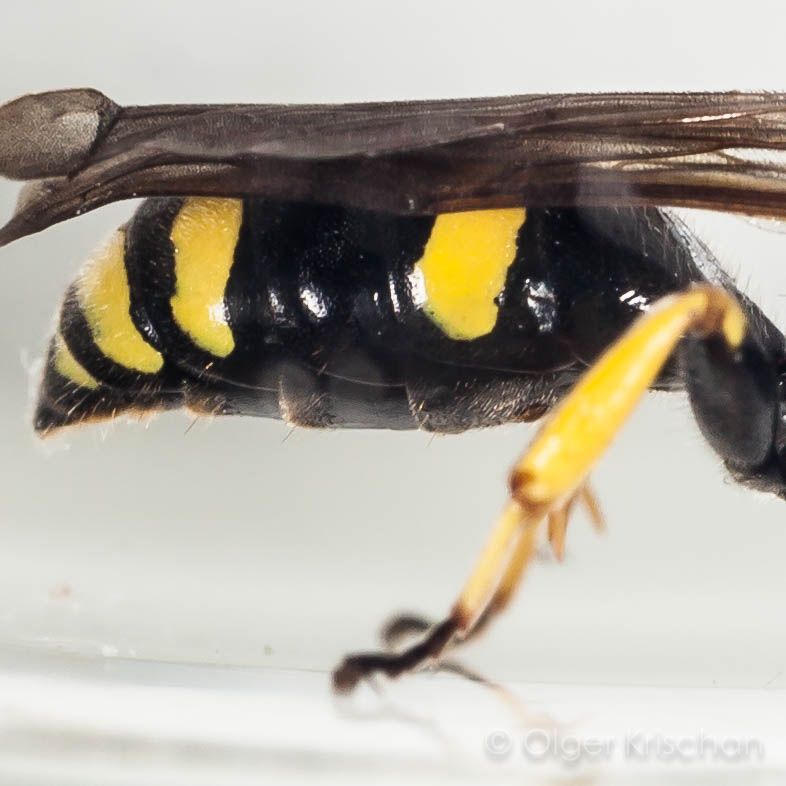Official name
Synonyms
Ectemnius continuus
Crabro continuus
Hypocrabro continuus
See also: www.gbif.org
Etymology:
continuus
Latin: uninterrupted
CONTENTS
1. Distribution
2. Behaviour
3. Plant relations
4. Prey relations
5. Parasitic relations
6. Identification
1. DISTRIBUTION
The diggerwasp Ectemnius continuus [1] is a common species that occurs throughout the Netherlands [2,3].
The E. continuus wasps occurring in the Benelux (Belgium Netherlands and Luxembourg) belong to the subspecies E. continuus punctatus [3,4].
2. BEHAVIOUR
2.1. ACTIVITY
The species is active from the beginning May until the beginning of October [2,4,5].
2.2. DEVELOPMENT
The female nests in dead wood, like branches, stubs and collapsed tree trunks. She gnaws a tunnel with branches and in each branch one or two brood cells [3,4,5,7]. Or the cells are created sequentially in a line [5]. The nest includes about 10 brood cells [3,4,5]. The main tunnel and the branches are filled with wood flour, small pieces of wood [5].
Every brood cell contains 6 to 8 prey [5].
Normally two generations are produced per year [5].
2.3. Bee hotel
The males use bee hotels as a sleeping place [6].
3. FOOD PLANTS
3.1. WOOD TYPES
The following wood types are mentioned in literature as medium for the wasp to built her nests in:
| Fagaceae | Quercus (Oak) [10] |
| Salicaceae (Willow family) | Populus (Poplar) [10] – Populus nigrus [10(als Popula nigra)] Salix (Willow) [10] – Salix alba [10] |
3.2. FOOD PLANTS
The adult wasps feed with plant nectar and/or pollen. In literature the following plants and groups are cited:
| Composite family [3] (Asteraceae) | – |
| Umbellifers [3,4,5] (Apicaceae) | – Wild angelica (Angelica sylvestris) [2] – Parsnip (Pastinaca sativa) [2] – Hogweed (Heracleum sphondylium) [2] |
The garden has some umbellifers but I have not seen this species on it yet.
4. PREY RELATIONS
The species uses flies as food for her offspring [3,4,5,7].
Literature cites the following species occurring in the Netherlands:
| Diptera (Flies) | Anthomyiidae (Anthomyiid flies) [5,7] Delia – Onion fly (Delia antiqua) [10(als Hedemiya antiqua -> Helemiya)] Calliphoridae (Blow flies) [4,5,7,10] Pollenia – Pollenia rudis [10] Muscidae (House flies) [4,5,7,10] Hydrotaea – Hydrotaea meteorica [10] Thricops – Thricops semicinereus [10(als Aricia semicinerea)] Rhagionidae (Snipe flies) [5,7] Sciomyzidae (Marsh flies) [7] Stratiomyiidae (Soldier flies) [7] Syrphidae (Hover flies) [4,5,7,10] Tabanidae (Horseflies) [4,7,10] Tachinidae (Tachnid flies) [5,7] Therevidae (Stilletto flies) [4,5,7,10] |
5. PARASITIC RELATIONS
The following nest parasites of E. continuus present in the Netherlands are mentioned in the literature:
| Ichneumonidae (Ichneumon wasps) | Enclisis – Enclisis macilenta [7 als Caenocryptus inflatus = Enclisis inflatus[12]] Hoplocryptus – Hoplocryptus confector [11] |
| Diptera (Flies) | Sarcophagidae (Flesh flies) Macronychia – Macronychia polyodon [9] |
Parasitic species outside the Netherlands [1]:
| Ichneumonidae (Ichneumon wasps) | Hoplocryptus – Hoplocryptus heliophilus [11] – Hoplocryptus quadriguttatus [11] |
6. IDENTIFICATION
Length males: 8 – 12 mm
Length females: 9,5 – 14,5 mm
Genus
The genus Ectemnius can be recognized by the following characters:
1. Frontwing with one submarginal cell [4,8]
2. Ocelli usually shaped in a obtuse isosceles triangle [3,8]
3. Tergites abdomen smooth with fine punctation, only on tergite 1 somewhat stronger [3,5,8]
4. Side thorax, metapleuron (M) and often side propodeum (P), with strong transverse wrinkles [3,5,8]
5. Head in frontal view broader than high [5,8]

6. Side thorax (mesopleuron) has a short transverse carina in front of the middle leg coxa [4,5,8].
♀
1. Antenna with 12 segments [3,5,8]
2. Abdomen with 6 segments [3,5,8]
♂



- Antenna with 12 segments [3,5,8]
2. Abdomen with 7 segments [3,5,8]
HEAD
1. Antennal segment 3 abaut 2,5x longer than wide [3,5,8]
2. Antennal segment 6 with cut out [5]
3. Inner edge mandible with large triangular tooth [3,5,8]
4. Smooth area above the antennal base not limited with a vertical carina [5,8]
THORAX
1. Side thorax, mesopleuron, wrinkled [3,5,8]
2. Mesonotum and usually tergite 1, and vertex [8] with long erect hairs [3,5,8]
3. First and second middle leg tarsal members thorn-like elongated [3,5,8]
4. Trochanter front leg without tooth, keel or bump [3,5,8]
5. Ventral side mesothorax with transverse carina at the front [8]
In species that do not bear this character the front is gradually rounded.
ABDOMEN
1. Yellow markings on tergite 3 absent or less developed than on tergite 4 [3,5,8]
2. Tergite 1 finely punctated, the space between the points several times larger than the points [8]

3. Last segment without pygidium [3,5]
Literature
1 Nederlands Soortenregister2 Waarneming.nl
3 KLEIN, Wim. De graafwespen van de Benelux. Jeugdbondsuitgeverij, Utrecht, 1996, 1-130. + KLEIN, Wim. De graafwespen van de Benelux: supplement. Jeugdbondsuitgeverij, 1999.
4 Peeters, T.M.J., C. van Achterberg, W.R.B. Heitmans, W.F. Klein, V. Lefeber, A.J. van Loon, A.A. Mabelis, H. Nieuwen-huijsen, M. Reemer, J. de Rond, J. Smit, H.H.W. Velthuis, 2004. De wespen en mieren van Nederland (Hymenoptera: Aculeata). – Nederlandse Fauna 6. Nationaal Natuurhistorisch Museum Naturalis, Leiden, knnv Uitgeverij, Utrecht & European Invertebrate Survey – Nederland, Leiden.
5 Blösch, M. (2000). Die Grabwespen Deutschlands – Lebens‐weise, Verhalten, Verbreitung. 71. Teil. In Dahl, F.: Die Tierwelt Deutschlands. Begr.: 1925. – Keltern (Goecke & Evers). – 480 S. 341 Farbfotos. ISBN 3‐931374‐26‐2 (hardcover). DM 98,–. Zool. Reihe, 78: 353-353. https://doi.org/10.1002/mmnz.20020780208
6 Breugel, P. van 2014. Gasten van bijenhotels. – EIS Kenniscentrum Insecten en andere ongewervelden & Naturalis Biodiversity Center, Leiden.
7 Ruchin, Alexander & Antropov, Alexander. (2019). Wasp fauna (Hymenoptera: Bethylidae, Chrysididae, Dryinidae, Tiphiidae, Mutillidae, Scoliidae, Pompilidae, Vespidae, Sphecidae, Crabronidae & Trigonalyidae) of Mordovia State Nature Reserve and its surroundings in Russia. Journal of Threatened Taxa. 11. 13195-13250. 10.11609/jott.4216.11.2.13195-13250.
8 Hermann Dollfuss, "Bestimmungsschlüssel der Grabwespen Nord- und Zentraleuropas (Hymenoptera, Sphecidae) mit speziellen Angaben zur Grabwespenfauna Österreichs", Publikation der Botanischen Arbeitsgemeinschaft am O.Ö.Landesmuseum Linz, LINZ, 20. Dezember 1991
9 POVOLNY, D. The flesh-flies of Central Europe (Insecta, Diptera, Sarcophagidae). Spixiana supplement, 1997, 24: 1-260.
10 WOYDAK, Horst. Hymenoptera Aculeata Westfalica Familia: Sphecidae (Grabwespen), 1996, 3-135.
11 Schwarz, Martin. (2007). Revision der westpaläarktischen Arten der Gattung Hoplocryptus THOMSON (Hymenoptera, Ichneumonidae). Linzer Biologische Beiträge. 39.
12 FITTON, Michael Geoffrey. A catalogue and reclassification of the Ichneumonidae (Hymenoptera) described by CG Thomson. 1982.

























